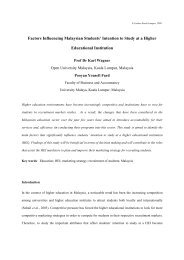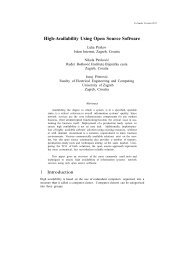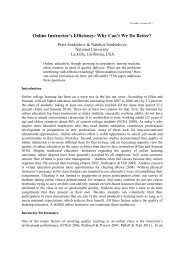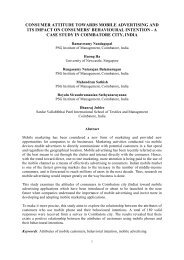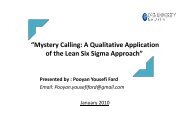Organizational Culture as a Source of Competitive Advantage - CASA
Organizational Culture as a Source of Competitive Advantage - CASA
Organizational Culture as a Source of Competitive Advantage - CASA
You also want an ePaper? Increase the reach of your titles
YUMPU automatically turns print PDFs into web optimized ePapers that Google loves.
E-Leader Bangkok, 2008<br />
channels, visible and comprehensible promotion and incentive criteria, effectively designed jobs, and<br />
widely shared exposure to customer feedback. To the extent that leaders effectively shape the appropriate<br />
cultural norms, they are translated into managerial and employee behaviors. In fact, it h<strong>as</strong> been noted that<br />
culture management h<strong>as</strong> displaced change management <strong>as</strong> the leadership practice that h<strong>as</strong> the greatest<br />
impact on firm performance (Brockbank, Ulrich, & Yakonich, 2002).<br />
One <strong>of</strong> the main re<strong>as</strong>ons why culture research h<strong>as</strong> been so prominent in recent years is because it holds out<br />
the promise that culture may be a factor in enhancing the effectiveness <strong>of</strong> individuals, groups, and<br />
organizations. This path from culture to performance ostensibly occurs because (a) the “right type” <strong>of</strong><br />
behavioral norms will motivate workers, incre<strong>as</strong>e morale, and enhance commitment to the firm’s strategy<br />
type and objectives (Kilman, Saxton, & Serpa, 1985); (b) Cultural values may clarify the behavioral norms<br />
<strong>of</strong> members (Schwartz & Davis, 1981); and (c) Through these activities, culture can enhance the firm’s<br />
adaptability and therefore its effectiveness and performance (Kotter & Heskett, 1992).<br />
Calori and Sarnin (1991) carried out a field study examining the link between corporate culture and<br />
economic performance. They operationalized culture <strong>as</strong> espoused values, instead <strong>of</strong> behavioral norms, but<br />
their results were positive nevertheless. They hypothesized relationships between values, management<br />
practices, and economic performance and concluded that strength <strong>of</strong> agreement around norms and cultural<br />
attributes appeared to be correlated to firm growth, while the correlation between pr<strong>of</strong>itability and cultural<br />
attributes w<strong>as</strong> less significant. Other researchers are applying the culture construct in a search for an ideal<br />
“marketing culture,” exploring the possibility <strong>of</strong> a relationship between a firm’s culture, its marketing<br />
strategy, and pr<strong>of</strong>itability. Webster, for example, (1993) found a significant relationship between service<br />
firm marketing culture, me<strong>as</strong>ured along six dimensions, and firm pr<strong>of</strong>itability.<br />
The suggestion that there is a link between culture and financial performance, in contr<strong>as</strong>t to behavioral<br />
effectiveness, is controversial. Some scholars argue that it may be impossible to substantiate such a link<br />
(Siehl & Martin, 1990). They suggest that there are conceptual and methodological “flaws” behind<br />
attempts to link culture and financial performance that, in turn, render the results empirically inconclusive<br />
(Siehl & Martin, 1990). They opine that the most that culture research can hope to do is establish<br />
relationships between culture and psychological and behavioral outcomes, such <strong>as</strong> motivation, team<br />
effectiveness, and commitment.<br />
The Relationship Between Motivation and Cultural Norms<br />
According to Klein (2003), Constructive cultural norms greatly enhance individual motivation while<br />
Aggressive and P<strong>as</strong>sive/Defensive norms reduce motivation levels. The nature <strong>of</strong> a firm’s culture provides<br />
important insights regarding a firm’s behavioral expectations for people, and they set forth the psychosocial<br />
environment. The respondents reported that the Constructive norms, favoring collaboration,<br />
creativity, and risk-taking behaviors, fostered high levels <strong>of</strong> motivation, which, in turn, should be reflected<br />
in member satisfaction and intention-to-stay.<br />
Aggressive and P<strong>as</strong>sive/Defensive cultural norms were negatively related to member motivation, according<br />
to the results. These Defensive cultures promote thinking and behaviors that discourage change efforts,<br />
support the status quo, discourage effective information exchange, and, in the process, generally reduce the<br />
motivation <strong>of</strong> individual workers.<br />
The Relationship Between Group Level Outcomes and Cultural Norms.<br />
Constructive norms are strongly and positively related to group-level me<strong>as</strong>ures <strong>as</strong> well (Klein, 2003). In<br />
contr<strong>as</strong>t, Aggressive- and P<strong>as</strong>sive/Defensive norms are significantly and negatively related to effective<br />
teamwork within units, coordination across units, and the quality <strong>of</strong> products/services at the unit level.<br />
The results highlight the differences in managing intra- and inter-group processes in Constructive versus<br />
Defensive cultures. The Defensive cultures are characterized by the “throw it over the wall” mentality, in<br />
which each <strong>of</strong> the functional units in, for example, the product development process do their part <strong>of</strong> the<br />
project and “throw it over the wall” to the next functional unit. They, in turn, fling it over the wall, and so<br />
6


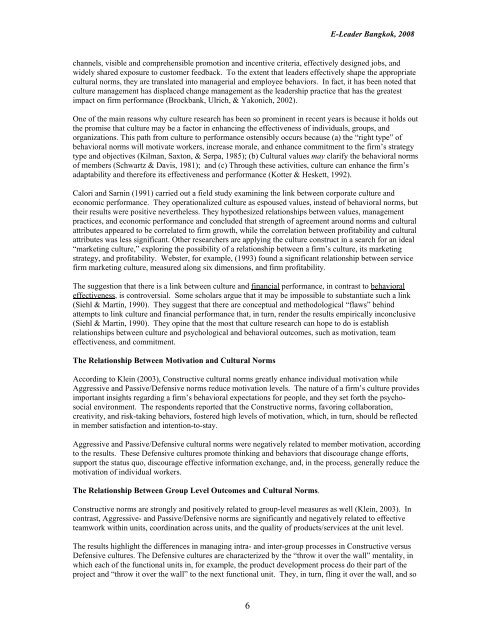
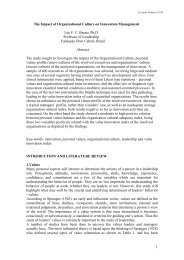
![Oberholzer [Compatibility Mode].pdf - CASA](https://img.yumpu.com/21081507/1/190x135/oberholzer-compatibility-modepdf-casa.jpg?quality=85)


